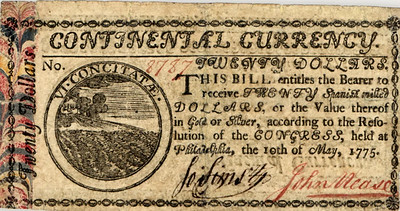
PREV ARTICLE
NEXT ARTICLE
FULL ISSUE
PREV FULL ISSUE
MARBLED MONEYThe nonprofit library JSTOR published a short article on the origin of marbling as a paper money anti-counterfeiting measure. Found via News & Notes from the Society of Paper Money Collectors (Volume IX, Number 40, March 19, 2024) -Editor Paper money was only the promise of value, so people had reason to be more skeptical of early banknotes. Creating a reliable cash currency has meant fighting against counterfeiters. Serial numbers, sophisticated plate engraving, special paper: central banks have used all kinds of techniques to create authentic banknotes that can be distinguished from fakes. One eighteenth-century option was marbling. Marbling, the printing of a marble-like pattern on paper by floating dyes on a water bath, was a technique that had been developed in Persia and India before spreading throughout the Ottoman Empire. When it made its way to Europe, it appealed to both artists and London's world of financiers, who used it on banknotes and bonds. As historian Jake Benson describes, the idea caught on fairly fast:
Within roughly a century of circa 1600, when Persian artist Muhammad Tahir developed his innovative marbling methods and produced his ubiquitous, intricately combed patterns in India, they were applied as the first polychrome security device on some of the earliest indented paper banknotes issued by the Bank of England in 1695.
Difficult to replicate, marbling was a way to make banknotes and checks unique. When the United States was trying to create its first currency, Benjamin Franklin brought to the table the idea of marbling as a security technique, based on his experiences with Those promissory notes—exchanged for hundreds of thousands of French livres—were critical for an aspiring republic that struggled to feed and clothe its army.
To read the complete article, see:
Wayne Homren, Editor The Numismatic Bibliomania Society is a non-profit organization promoting numismatic literature. See our web site at coinbooks.org. To submit items for publication in The E-Sylum, write to the Editor at this address: whomren@gmail.com To subscribe go to: https://my.binhost.com/lists/listinfo/esylum All Rights Reserved. NBS Home Page Contact the NBS webmaster 
|

